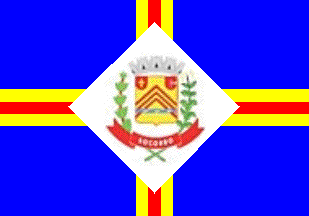 image by
Ivan Sache,
16 February 2013
image by
Ivan Sache,
16 February 2013Based on: http://www.socorro.sp.gov.br/brasaobandeiraehino.asp

Last modified: 2013-02-25 by ian macdonald
Keywords: sao paulo | socorro |
Links: FOTW homepage |
search |
disclaimer and copyright |
write us |
mirrors
 image by
Ivan Sache,
16 February 2013
image by
Ivan Sache,
16 February 2013
Based on:
http://www.socorro.sp.gov.br/brasaobandeiraehino.asp
An upright red cross, bordered yellow, on a blue field with the municipal arms in the centre on a white lozenge.
Official website at
http://www.socorro.sp.gov.br
Dirk Schönberger,
12 February 2013
Socorro was founded in the second half of the 18th century by Simão de Toledo Pizza, who was granted a domain at the origin of the Vila de São José de Toledo. A chapel dedicated to Our Mother of Perpetual Help ("Nossa Senhora do Perpétuo Socorro") was erected on the site of the today's main church of the town. The first mass was celebrated on 9 August 1829, which is considered as the day of foundation of the town. The municipality of Socorro was established in 24 March 1871. Socorro was proclaimed a Health Resort on 24 April 1945 and a Tourist's Resort in 1978..
The flag of Socorro was designed by Arcinoé Antônio Peixoto de Faria, in compliance with the Portuguese heraldic tradition inherited by Brazil. The flag is blue, quartered by a yellow-red-yellow cross. In the middle of the flag is placed a white lozenge charged with the municipal coat of arms.
Photo of the flag
http://www.camarasocorro.sp.gov.br/201202/?p=1144
The coat of arms represents the municipal government while the white lozenge that surrounds it represents the town as the seat of the municipality. The stripes divide the flag in quarters representing the rural estates located on the municipal territory. The dimensions of the flag are 14 units x 20 units.
The coat of arms of Socorro was designed by Egidio José Porto, under the heraldic authority of Arcinoé Antônio Peixoto de Faria. "A Samnitic shield surmounted by an eight-towered mural crown argent, or three chevrons gules in base a fess wavy azure charged with three fish nageant argent, the chief cantonned by two escutcheons, dexter gules a fleur-de-lis or sinister gules an armoured arm issuing from sinister holding a key all argent. The shield supported dexter by a branch of coffee fructed proper and sinister by a plant of tobacco proper. Beneath the shield a scroll gules inscribed with the municipality's name in letters argent."
The Samnitic shield, the first style of shield introduced from France to Portugal and inherited by the Brazilian heraldry, evokes the colonizers and main builders of the country. The mural crown is a symbol of municipal emancipation, representing a second-rank town, seat of a "comarca". The shield "Or three chevrons gules" is the arms of the Dorta family, founder of the town. Or is a symbol of glory, splendour, greatness, wealth and sovereignty. Gules is a symbol of dedication, patriotic love, audacity, intrepidity, courage and valiance. The fess wavy represents [as a rebus] Rio do Peixe [Fish River], which waters Socorro. Azure is a symbol of justice, nobleness, perseverance, zeal and loyalty. Argent is a symbol of peace, work, friendship, prosperity, purity and religious feeling. The escutcheon in chief dexter is a tribute to the Blessed Virgin, the town's patron saint. The escutcheon in chief sinister is a symbol of the hospitality of the people, representing the friendly offer of the town's key. The branch of coffee and the plant of tobacco represent the main crops growing on the generous and fertile soil, being the main source of income for the municipality.
Ivan Sache, 16 February 2013